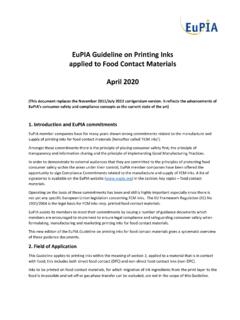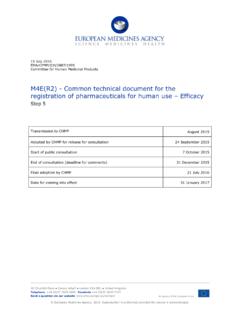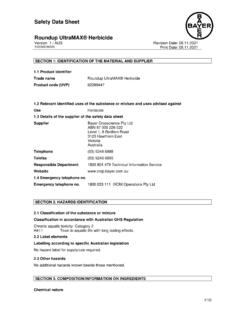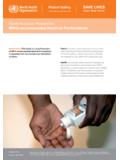Transcription of Supporting effective implementation of EC External Assistance
1 Supporting effective implementation of EC External AssistanceEuropean CommissionEuropeAid Cooperation OfficeRue de la Loi 41 B-1049 BrusselsFax (32-2) 299 64 07E-mail: DGRue de Gen ve 12 B-1140 BrusselsFax (32-2) 299 25 25E-mail: Cycle Management GuidelinesTABLE OF CONTENTSACKNOWLEDGEMENTS ---------------------------------------- ---------------------------------------- -----------------------------viiABBREVIA TIONS ---------------------------------------- ---------------------------------------- ---------------------------------------v iii1 INTRODUCTION PURPOSE OF THE guidelines USERS AND OVERVIEW OF CONTENTS ---------------------------------------- ---------------------------------------- -------------------3 PART 12 EUROPEAN COMMISSION DEVELOPMENT COOPERATION POLICY PARTNERSHIP STRATEGIES WITH DEVELOPING COUNTRIES NEW DIRECTIONS IN DEVELOPMENT COOPERATION POLICY CROSS CUTTING OWNERSHIP AND PARTICIPATION ---------------------------------------- ---------------------------------------- --------63 THE PROJECT WHAT IS A PROJECT?
2 WEAKNESSES OF THE PROJECT APPROACH SECTOR APPROACH AND BUDGETARY IMPLICATIONS FOR EC SUPPORT TO When is a project appropriate? Improving the quality of projects ---------------------------------------- ---------------------------------------- 144 PCM OPERATIONAL guidelines OVERVIEW The cycle of operations PCM and managing Calls for Proposals PCM principles and the Logical Framework Approach Key documents and responsibilities Decision making points, options and lead responsibilities Quality support and assessment system The financing decision PROGRAMMING The programming process IDENTIFICATION Key tasks and Key assessments and tools Assessment criteria and Key documents Deciding next steps Key tasks and Key assessments and tools Assessment criteria and Key documents Deciding next steps ---------------------------------------- ---------------------------------------- -------------------38ivSection 5.
3 The Logical Framework implementation , INCLUDING MONITORING AND REPORTING Main periods Definition of monitoring, regular review, evaluation and audit Key tasks and Key assessments, tools and Information collection and use - overview Assessment criteria and Deciding next steps Purpose and Key tasks and Tools and key documents Information requirements and evaluation criteria Decision options AUDIT Purpose and Key tasks and Tools and key documents Information requirements and audit criteria Decision options ---------------------------------------- ---------------------------------------- -----------------------53 PART 25 THE LOGICAL FRAMEWORK APPROACH OVERVIEW OF THE LOGICAL FRAMEWORK APPROACH Background What is it? Link to the project cycle and key PCM documents Practical issues in applying the Logframe Two main stages THE ANALYSIS STAGE Preparatory Stakeholder Problem Analysis Analysis of Objectives Analysis of Strategies THE PLANNING STAGE The Matrix format, terminology and the process of First Column: Intervention Logic Fourth Column: Assumptions Second and third columns: Indicators and Source of Verification Completing the draft Logframe matrix ACTIVITY, RESOURCE AND COST SCHEDULES Overview A Checklist for Preparing an Activity Preparing resource and cost USING THE LFA DURING FORMULATION, implementation , EVALUATION AND A NOTE ON INTERLOCKING OR NESTED LOGFRAMES ---------------------------------------- ----------------946 INSTITUTIONAL CAPACITY WHY?
4 WHEN? WHAT AND HOW?------------------------------------ ---------------------------------------- ---------------------------------95vProj ect Cycle Management Guidelines7 MONITORING, REVIEW AND REPORTING INTRODUCTION Purpose Definitions Principles of good Key steps in developing a project based monitoring system TOOLS The Logical Framework Risk management Basic data analysis to generate performance Checklist for planning a short monitoring visit Using question checklists for semi-structured interviews Reviewing administrative and management Checklist for managing regular review Progress reports and updated plans CRIS implementation Report format ---------------------------------------- --------------------------------1178 PARTICIPATION & FACILITATION PROMOTING PARTICIPATION AND OWNERSHIP Objectives of participatory approaches Principles Approach Intensity of Promoting ownership FACILITATION SKILLS How we learn and what we remember Adult
5 What makes a good participatory trainer/facilitator Workshop Preparation ---------------------------------------- ---------------------------------------- -------------1229 PREPARING TERMS OF PURPOSE USING TOR IN THE PROJECT FORMAT AND CONTENT OF TOR Background to the assignment Study objectives Issues that might be included in a study/mission TOR Methodology Expertise Reporting Work plan and time-schedule ---------------------------------------- ---------------------------------------- ---135 ATTACHMENTS ---------------------------------------- ---------------------------------------- ---------------------------------------- ----136A1 - GLOSSARY OF KEY TERMS----------------------------------- ---------------------------------------- -----------------------136A2 - USEFUL REFERENCES ---------------------------------------- ---------------------------------------- -------------------------147viSection 5: The Logical Framework Approach7viiACKNOWLEDGEMENTST hese guidelines have been prepared for the European Commission by the staff of the Aid Delivery MethodsHelpdesk with the support of, and input from, a significant number of staff within the European AidCooperation Office (EuropeAID).
6 It would be inappropriate to try and name all individuals who havecontributed, however thanks to all those who have provided their time and ideas. The work was directed by EuropeAID s Unit O3, which is responsible for Innovation, Thematic Research, theQuality Support Group and Financing Committees. Comments on these guidelines should be directed toVirginia Manzitti, who can be contacted by email at previous PCM manual of 2001 and the PCM Handbook of 2002 have been important source is given in the text (as footnotes) where materials are knowingly drawn from other sourcedocuments. Electronic copies of this Guideline (and other related reference documents) can be accessed through the internet at: Cycle Management GuidelinesviiiABBREVIATIONSAIDCOE uropeAid Co-operation OfficeALA Asia and Latin America (ALA) countriesATM Audit Task ManagerAWPA nnual Work PlanBABudgetary AidCFPsCall for ProposalsCRISC ommon Relex Information SystemCSPC ountry Strategy PaperDACD evelopment Assistance CommitteeDGDirectorate-GeneralDG DEVD evelopment Directorate-GeneralDG RELEXE xternal Relations Directorate-General ECEuropean CommissionECHOE uropean Commission Humanitarian OfficeEcoFin AnalysisEconomic and Financial AnalysisEDFE uropean Development FundEUEuropean UnionEuropeAidEuropeAid Co-operation OfficeFA and FPFinancing Agreement and Financing ProposalGTZG erman Agency for technical Co-operationHoUHead of UnitHQEC Headquarters in Brussels IMFI nternational Monetary Fund LFLogical Framework LFA and LFML ogical Framework Approach and Logical Framework MatrixM&EMonitoring and Evaluation MDGM illenium Development Goals MEDAM editerranean (MED)
7 Countries (signatories to the Barcelona process)NIPN ational Indicative Programme OECDO rganisation for Economic Co-operation and DevelopmentOFSO rder For ServiceOVIO bjectively Verifiable IndicatorOWPO verall Work PlanPCMP roject Cycle ManagementPISP roject Identification SheetPGPartner Government PRSPP overty Reduction Strategy PaperQSGQ uality Support GroupRELEXE xternal RelationsSASector ApproachSOVS ource of VerificationSPSPS ector Policy Support ProgrammeSWOTS trengths, Weaknesses, Opportunities and Threats TORT erms of ReferenceUNDPU nited Nations Development ProgrammeIn 1992 the European Commission adopted ProjectCycle Management (PCM) as its primary set ofproject design and management tools (based on theLogical Framework Approach), and a first PCMmanual was produced in 1993. The manual wassubsequently updated in 2001, shortly after thepublication of the EC s most recent DevelopmentPolicy document (April 2000).
8 A decision was made in early 2003 to update the PCMmanual again (now referred to as the PCM guidelines ) as a result of: experience gained through implementing the new development policy; issues raised by the ongoing international debateon aid effectiveness; and feedback from participants attending PCMtrainingThe main refinements that have been made include: Nevertheless, much of the core material/informationpresented in the previous PCM Manual andHandbook remains relevant and has therefore beenincorporated in this latest Purpose of the guidelinesThese guidelines have been prepared to supportongoing improvements in the quality of EC develop-ment Assistance . Quality is defined primarily in termsof the relevance, feasibilityand effectivenessof theprogrammes and projects supported with EC funds,including how well they are managed.
9 More specifically, the guidelines aim to support goodmanagement practices and effective decision makingthroughout the project management cycle fromprogramming, through to identification, formula-tion, implementation and evaluation. The Guide-lines aim to promote consistency and clarity ofapproach, while allowing for the operationalflexibility required of a dynamic and diverse externalassistance programme. The guidelines therefore provide: A description of the policy framework withinwhich EC development Assistance is provided,and the role of the project in relation to otheraid delivery modalities;1 Section 1: Introduction11 See also the guidelines for EC Support to Sector Programmes and Guide to the programming and implementation of Budget Support to third countries . 1. INTRODUCTION1. Clarifying the main implications of the EC sDevelopment Policy with regard to the choiceof aid delivery modality (namely projects,sector policy support programmes and/orbudgetary aid);2.
10 Highlighting the importance of conducting an appropriate level of institutional andorganisational capacity assessment duringproject identification and formulation; 3. Removing Financing as a single stage in thecycle, given that the financing decision istaken at different times depending on the ECRegulation under which projects are financed(sometimes at the end of Identification andsometimes after Formulation );4. Incorporating some additional information onoperational tasks and responsibilities at eachstage of the cycle;5. Providing a set of key quality attributes,criteria and standards (the Quality Frame) that can be consistently applied through the identification, formulation and implemen-tation stages of the project cycle; and6. Updating the guidelines on the LogicalFramework Approach and providing referenceto some additional analytical tools which cansupport effective PCM.
















